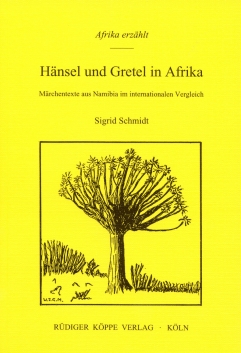


Some people would be surprised to hear that African grandmothers tell their grandchildren fairy tales that are familiar to Europeans – fairy tales that did not come from books, but were passed down from generation to generation. When we hear these stories, we become reacquainted with Hansel and Gretel, and other characters from European fairy tales.
In total, the author was able to find nearly 90 internationally known fairy tale figures who are the protagonists of Namibian fairy tales. In this volume, she presents 45 texts which she recorded and transcribed; a fascinating mixture of long-known material and its African adaptation where the European heroes have African characteristics:
Die Menschenfresserin und die Schulkinder / Der Schlangensohn / Die drei Wünsche / Das wunderbare Vogelherz / Der Wahrsager, der Zimmermann, der Dieb und der Schütze / Die hölzerne Frau / „Wir drei!“ / Siebenkopfs Tochter / Die Krähe als Arzt / Das gute und das schlechte Mädchen / Die Eierkinder und ihre Schwester / Die drei geraubten Prinzessinnen / Der Garten des Löwen / Die Lügenkleider des Schakals / Der Schakal als Geigenlehrer / Der Soldat und das Ungeheuer / Die kluge Tochter / Der Sack, der Spiegel und das Wasser / Die böse Schwester / Die Zwillingssöhne des Fischers / Das Mädchen ohne Arme / Der dankbare Tote / Der arme Junge und die Rätselprinzessin / Das Kalb Selan / Der arme Junge und sein Kalb / Der Waisenjunge, die Ziege und das Kalb / Die schwatzhafte Frau / Der Ovambo, der kein Afrikaans verstand / Der König und seine sechs Töchter / Lieb wie das Salz / Die vier Wanderer / Die Sonne bringt es an den Tag / Der Junge mit der Sonne und dem Mond / Die Zwillingssöhne mit Mond und Stern auf der Brust / Die Königstochter und das Apfelwerfen / Die Königstochter und das Pferdespringen / Der Bär, der Duiker und das Vögelchen / Die Zwillingsbrüder Jannie und Pieter / Die Königstochter und die sechsköpfige Schlange / Das Tischleindeckdich und die Spukteufel / Die fliegende Blume / Der Mann mit dem Hundefell / Der schweigende Vater und der kühne junge Mann / Die endlose Geschichte / Opesa haba ge uhâ i aob xa = Von dem Mann, der ein träges Pferd hatte (Nama/German)
In the second and third sections, the author explores the question of how these fairy tales came to Namibia. She establishes that at least three dozen come from the Afrikaans oral repertory, which accompanied the South African Coloured to Southwest Africa / Namibia in the last century.
In this way, Namibia has become the retreat of the oral tradition of these fairy tales, which tend only to exist in print in other countries. Through comparative research, the author shows that a number of versions of the same fairy tales must have coexisted at the Cape. She also gives evidence of the continued existence of Asian fairy tales from India and Indonesia in Namibia.
In her Catalogue of the Khoisan Folktales of Southern Africa, re-edited in 2013, Sigrid Schmidt lists all tales which were told by Khoisan people and said to have been learned orally. The catalogue consists of two volumes that can be ordered separately or together:
© 2025 by Rüdiger Köppe Verlag – www.koeppe.de